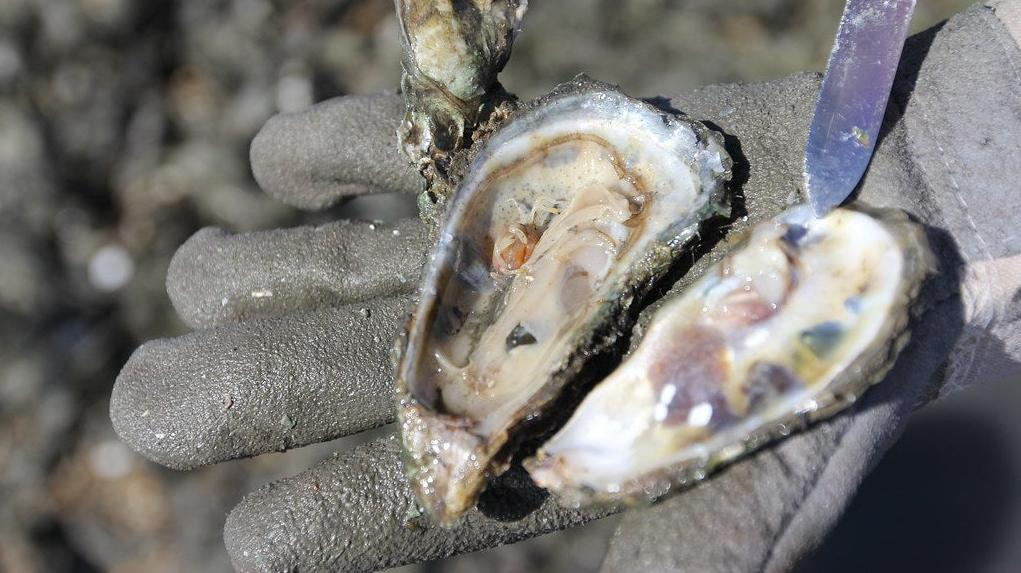Uh, What Did I Just Find Inside My Oyster?
Pea crabs are an oyster’s occasional hitchhiker, and yes, you can eat them.
Back when I was working for a restaurant, we had a few weeks where we ran a simple special involving wood fire roasted oysters with herb butter. It was remarkable for multiple reasons: we almost never sold non-pizza-related specials (so they were fun to cook, especially using live fire), the cooked oysters were delicious, and finally, when shucking the little oceanic gems, we made a puzzling discovery: Some of the oysters contained ghostly translucent crabs with an orange carapace, most of which were alive when we shucked the oysters.
The oysters themselves were perfectly good, seemingly unaffected by the tiny crabs. We evicted the little guys with a flick of the oyster-shucking knife before preparing each order.
Of course, the staff was endlessly fascinated by the crabs. Once the initial surprise wore off, we decided they were awesome and kept getting excited when we found another. One staff member salted some water and even tried to keep one as a pet, which didn't work out too well (RIP, little crab). But what were these guys, exactly?
Turns out, the little orange hitchhikers are known as pea crabs or oyster crabs. And finding them inside your oysters is perfectly normal.
What is a pea crab?
Pea crabs are soft-shelled crabs that take residence inside bivalves such as oysters and mussels. As you might have surmised, they're a type of parasite, one called kleptoparasites, which steal food from their hosts in order to live. White Stone Oyster Company, located in Chesapeake Bay, has written a handy primer about pea crabs. Even though the little rascals are classified as parasites, they don't cause any much noticeable damage to an oyster, if any at all.
When the wee crabs are larvae, they will find a host shellfish to call home. Their main food source is taking bits of whatever the oyster filters in for itself (mmm, silt). The crab will nestle into the gills of the oyster and thrive within its bigger roommate, the latter of which is probably unaware of the crab's existence.
Pangea Shellfish Company, another purveyor of shellfish, also says that you can even find more than one crab in the same oyster, because that's where pea crabs lay their eggs. Maybe that's about as lucky as finding a double-yolked egg!
Do pea crabs live everywhere?
According to White Stone Oyster Company, pea and oyster crabs primarily live in the warmer waters of the Atlantic Ocean. So if you've just bought yourself a dozen oysters from the Pacific, don't expect any little orange crabs to greet you when you start shucking.
The crabs are more prevalent in wild oysters than farmed ones, too. Conditions favorable for baby wild oysters are are also good for baby pea crabs, which is why you're more likely to see the little guys from a wild oyster harvest than a farmed one.
Are pea crabs edible?
In one word: yes. And people have known about them for a long time now.
The New York Times published a small article about them in 1907 (!!!) called "A Rare Delicacy, Little Known," which you can view here. The Times described pea crabs as "the little soft-shelled creature of the sea that seems to have all the sweetness and delicate salt savors of the entire crab family concentrated in its tiny body."
The paper suggests the crabs be served multiple ways. One way is to dress them lightly with mayonnaise with a garnish of lemon. Another is to heat them through gently, with butter, and spoon them over toast, with a sprinkling of paprika on top. Yet another way is to deep-fry them, coated in cracker crumbs. You eat the whole crab, shell and all; since they really are just over the size of a fat pea, their paper-thin shells are indeed edible.
But the easiest way to eat them is completely raw, along with the oyster. I can imagine some of you are skeeved by the idea, but... aren't you already eating a raw oyster? (I know, I know, oysters don't have legs or visibly walk around or anything, so I'm sure there's a mental hurdle there for some.) They have a salty and somewhat concentrated crabby taste that's considered by some, including the Times writer back in 1907, to be a little sweet.
While they are considered quite the delicacy, I can't imagine you'd ever see them as a dish on a menu, only because the yield would be so low. They're called pea crabs for a reason. Plus you'd have to open up a lot of oysters to get enough for even an appetizer's worth of food.
I’m a huge fan of oysters. How come I haven’t seen a pea crab yet?
If you're someone who regularly orders oysters at a restaurant, you might wonder why you've never seen a pea crab. Well, to be honest, the person doing the shucking or preparing in the kitchen (like me) was probably picking the crabs out for you. Imagine seeing one for the first time at a restaurant, not knowing what it was. That would be countless orders of oysters sent right back to the kitchen!
For the record, as an employee, the first time I encountered one, I made sure to look them up immediately to make sure the oysters were still safe to eat. In fact, that the crabs were still alive was a good reassurance that the delicious oysters were still in great shape.
So if you ever encounter the little critters while shucking some oysters at home, or while out at a restaurant along a coast somewhere, just consider a pea crab a sign of good luck, and a bonus addition to your already delicious oyster.
